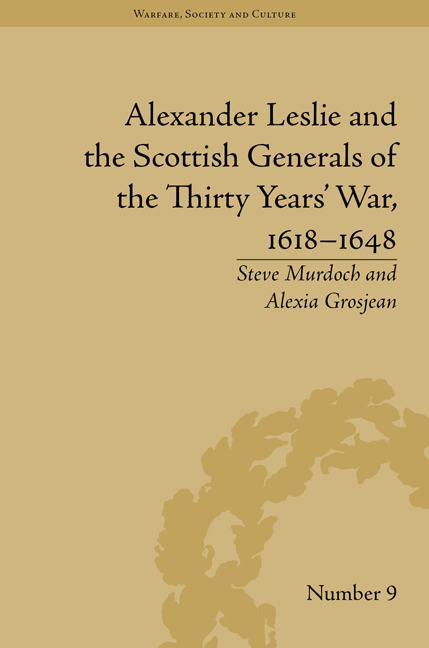Refine search
Actions for selected content:
15418 results in Military history
5 - The Home Front: Leslie, Ruthven and the Bishops' Wars, 1638–41
-
- Book:
- Alexander Leslie and the Scottish Generals of the Thirty Years' War, 1618–1648
- Published by:
- Pickering & Chatto
- Published online:
- 05 December 2014, pp 93-118
-
- Chapter
- Export citation
3 - From the Mamluks to the Mansabdars, 1200–1740
-
- Book:
- Military Manpower, Armies and Warfare in South Asia
- Published by:
- Pickering & Chatto
- Published online:
- 05 December 2014, pp 45-70
-
- Chapter
- Export citation
6 - The Scottish ‘Veteran Generals’ in England, 1642–7
-
- Book:
- Alexander Leslie and the Scottish Generals of the Thirty Years' War, 1618–1648
- Published by:
- Pickering & Chatto
- Published online:
- 05 December 2014, pp 119-144
-
- Chapter
- Export citation
Conclusion
-
- Book:
- Military Manpower, Armies and Warfare in South Asia
- Published by:
- Pickering & Chatto
- Published online:
- 05 December 2014, pp 163-166
-
- Chapter
- Export citation
4 - Canada
-
-
- Book:
- Citizen Soldiers and the British Empire, 1837–1902
- Published by:
- Pickering & Chatto
- Published online:
- 05 December 2014, pp 79-100
-
- Chapter
- Export citation
2 - The Scottish Military Diaspora
-
- Book:
- Alexander Leslie and the Scottish Generals of the Thirty Years' War, 1618–1648
- Published by:
- Pickering & Chatto
- Published online:
- 05 December 2014, pp 25-46
-
- Chapter
- Export citation
List of Maps and Tables
-
- Book:
- Military Manpower, Armies and Warfare in South Asia
- Published by:
- Pickering & Chatto
- Published online:
- 05 December 2014, pp xi-xviii
-
- Chapter
- Export citation
7 - Going Full Circle: The New Scottish Command in Europe, 1639–48
-
- Book:
- Alexander Leslie and the Scottish Generals of the Thirty Years' War, 1618–1648
- Published by:
- Pickering & Chatto
- Published online:
- 05 December 2014, pp 145-168
-
- Chapter
- Export citation
Works Cited
-
- Book:
- Alexander Leslie and the Scottish Generals of the Thirty Years' War, 1618–1648
- Published by:
- Pickering & Chatto
- Published online:
- 05 December 2014, pp 257-278
-
- Chapter
- Export citation
Stylistic Conventions
-
- Book:
- Alexander Leslie and the Scottish Generals of the Thirty Years' War, 1618–1648
- Published by:
- Pickering & Chatto
- Published online:
- 05 December 2014, pp xi-xii
-
- Chapter
- Export citation
Dedication
-
- Book:
- Alexander Leslie and the Scottish Generals of the Thirty Years' War, 1618–1648
- Published by:
- Pickering & Chatto
- Published online:
- 05 December 2014, pp vi-vi
-
- Chapter
- Export citation

The Soldier's Manual of Sanitation
- And of First Help in Sickness and When Wounded
-
- Published online:
- 05 December 2014
- Print publication:
- 13 February 2014
CONTENTS
-
- Book:
- War and the Militarization of British Army Medicine, 1793–1830
- Published by:
- Pickering & Chatto
- Published online:
- 05 December 2014, pp v-vi
-
- Chapter
- Export citation
5 - India
-
-
- Book:
- Citizen Soldiers and the British Empire, 1837–1902
- Published by:
- Pickering & Chatto
- Published online:
- 05 December 2014, pp 101-120
-
- Chapter
- Export citation

Military Manpower, Armies and Warfare in South Asia
-
- Published by:
- Pickering & Chatto
- Published online:
- 05 December 2014
-
- Book
- Export citation

Alexander Leslie and the Scottish Generals of the Thirty Years' War, 1618–1648
-
- Published by:
- Pickering & Chatto
- Published online:
- 05 December 2014
-
- Book
- Export citation
Frontmatter
-
- Book:
- Military Manpower, Armies and Warfare in South Asia
- Published by:
- Pickering & Chatto
- Published online:
- 05 December 2014, pp i-iv
-
- Chapter
- Export citation
1 - The Low Countries and the West Indies
-
- Book:
- War and the Militarization of British Army Medicine, 1793–1830
- Published by:
- Pickering & Chatto
- Published online:
- 05 December 2014, pp 11-30
-
- Chapter
- Export citation
CONTENTS
-
- Book:
- Alexander Leslie and the Scottish Generals of the Thirty Years' War, 1618–1648
- Published by:
- Pickering & Chatto
- Published online:
- 05 December 2014, pp v-v
-
- Chapter
- Export citation
1 - Warfare and Military Manpower Mobilization in Ancient India, 1500 bc–ad 550
-
- Book:
- Military Manpower, Armies and Warfare in South Asia
- Published by:
- Pickering & Chatto
- Published online:
- 05 December 2014, pp 9-26
-
- Chapter
- Export citation
